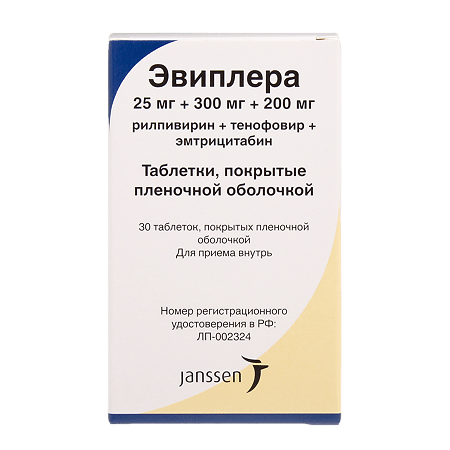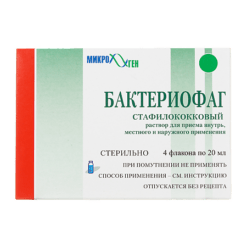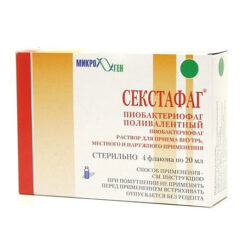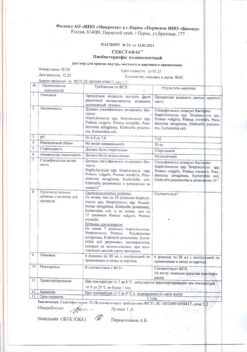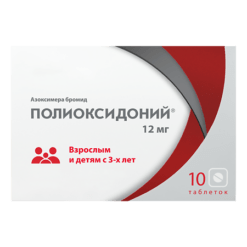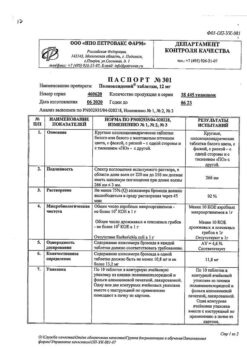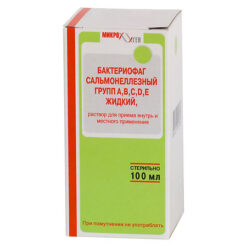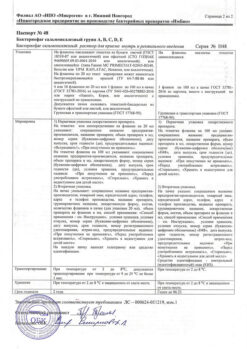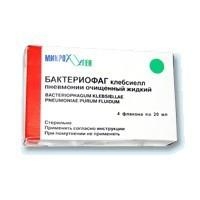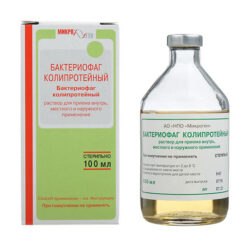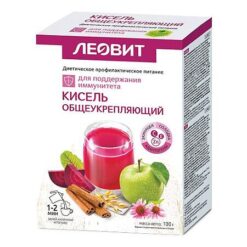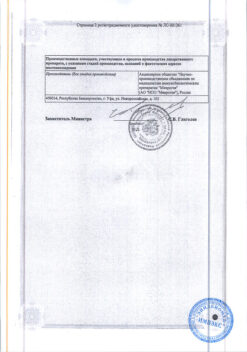No products in the cart.
Eviplera, 200 mg+25 mg+300 mg 30 pcs
€1.00
Out of stock
(E-mail when Stock is available)
Description
Pharm Action:
Emtricitabine is a nucleoside analogue of cytidine. Tenofovir disoproxyl fumarate is converted in vivo to tenofovir, a nucleoside monophosphate (nucleotide) analogue of adenosine monophosphate.” Both emtricitabine and tenofovir have specific activity against human immunodeficiency virus (HIV-1 and HIV-2) and hepatitis B virus.
Rilpivirine is a diarylpyrimidine non-nucleoside inhibitor of HIV-1 reverse transcriptase. Rilpivirine activity is mediated by non-competitive inhibition of HIV-1 reverse transcriptase.
The emtricitabine and tenofovir are phosphorylated by cellular enzymes to form emtricitabine triphosphate and tenofovir diphosphate, respectively. In vitro studies have shown that both emtricitabine and tenofovir can be completely phosphorylated when simultaneously in the cell.
Emtricitabine triphosphate and tenofovir diphosphate inhibit HIV-1 reverse transcriptase through a competitive mechanism, leading to termination of viral DNA chain synthesis.
All emtricitabine triphosphate and tenofovir diphosphate are both weak inhibitors of mammalian DNA polymerase. In vitro and in vivo data on their toxicity to mitochondria are not available. Rilpivirin does not inhibit human cellular α and β DNA polymerase and mitochondrial γ DNA polymerase.
In vitro antiviral activity:
The combination of emtricitabine, rilpivirine and tenofovir shows synergistic antiviral activity on cell culture.
The antiviral activity of emtricitabine against laboratory and clinical HIV-1 isolates was evaluated on lymphoblastoid cell lines, MAGI-CCR5 cell lines and peripheral blood mononuclear cells. Values of the 50% effective concentration (EC50) of emtricitabine ranged from 0.0013 to 0.64 μmol.
Emtricitabine exhibits antiviral activity on cell culture against HIV-1 subtypes A, B, C, D, E, F, and G (EC50 value range 0.007 to 0.075 μmol) and specific activity against HIV-2 strains (EC50 value range 0.007 to 1.5 μmol).
. In studies of combinations of emtricitabine with nucleoside reverse transcriptase inhibitors (NRTIs) (abacavir, didanosine, lamivudine, stavudine, tenofovir and zidovudine), non-nucleoside reverse transcriptase inhibitors (NNRTIs) (delavirdine, efavirenz, nevirapine and rilpivirine) and protease inhibitors (PIs) (amprenavir, nelfinavir, ritonavir and saquinavir) had additive or synergistic effects.
Rilpivirine exhibits activity against laboratory wild-type HIV-1 strains on an acutely infected T-cell line with a median EC50 HIV-1/IIIB value of 0.73 nmol (0.27 ng/mL). Although in vitro rilpivirine has demonstrated limited activity against HIV-2 with EC50 values ranging from 2.510 to 10.830 nmol (920 to 3970 ng/mL), rilpivirine hydrochloride is not recommended for treatment of HIV-2 infection in the absence of clinical data.
. Rilpivirine also demonstrated antiviral activity against a wide range of primary Group M (subtype A, B, C, D, F, G, H) HIV-1 strain isolates with EC50 values ranging from 0.07 to 1.01 nmol (0.03 to 0.37 ng/mL) and primary Group O isolates with EC50 values ranging from 2.88 to 8.45 nmol (1.06 to 3.10 ng/mL). The antiviral activity of tenofovir against laboratory and clinical HIV-1 isolates was evaluated on lymphoblastoid cell lines, mainly on monocytes/macrophages and on peripheral blood lymphocytes. The EC50 values of tenofovir ranged from 0.04 to 8.5 μmol.
Tenofovir demonstrated antiviral activity on cell culture against HIV-1 subtypes A, B, C, D, E, F, G and O (EC50 value range 0.5 to 2.2 μmol) and specific activity against HIV-2 strains (EC50 value range 1.6 μmol to 5.5 μmol).
. In studies of combinations of tenofovir with NRTIs (abacavir, didanosine, emtricitabine, lamivudine, stavudine and zidovudine), NRTIs (delavirdine, efavirenz, nevirapine and rilpivirine) and IPs (amprenavir, indinavir, nelfinavir, ritonavir and saquinavir) an additive or synergistic effect was observed.
Resistance:
Cell culture
Resistance to emtricitabine or tenofovir has been observed in vitro and in some HIV-1-infected patients due to substitution in the M184V or M184I reverse transcriptase (RT) codons for emtricitabine or in the K65R reverse transcriptase codon for tenofovir. No other mechanisms of resistance to emtricitabine or tenofovir have been identified. Emtricitabine-resistant viruses with the M184V/I mutation showed cross-resistance to lamivudine but remained sensitive to didanosine, stavudine, tenofovir, zalcitabine, and zidovudine.
Mutation in the K65R codon may also be associated with resistance to abacavir or didanosine and lead to decreased sensitivity to these drugs as well as to lamivudine, emtricitabine, and tenofovir. Tenofovir disoproxil fumarate should not be administered to patients with K65R HIV-1 mutations. HIV-1 with mutations in the K65R, M184V and K65R+M184V codons remains completely sensitive to rilpivirine.
Rilpivirine- and NNRTI-resistant strains have been isolated on cell cultures from wild-type HIV-1 of various nature and subtypes. The most frequently observed resistance-associated mutations were L100I, K101E, V108I, E138K, V179F, Y181C, H221Y, F227C, and M230I.
Given all available in vitro and in vivo data in patients who have not previously received antiretroviral therapy, the following mutations may affect Evipler activity: K65R, K101E, K101P, E138A, E138G, E138K, E138Q, E138R, V179L, Y181C, Y181I, Y181V, M184I, M184V, H221Y, F227C, M230I and M230L (if identified before treatment). These resistance-related mutations should only be considered when using Evipler to treat patients who have not previously received antiretroviral therapy.
These resistance-related mutations have only been identified from in vivo data in previously untreated patients, and therefore cannot be used to predict Evipler activity in patients with virologically ineffective antiretroviral therapy.
As with other antiretrovirals, genotypic resistance testing should be performed while taking Evipler.
HIV-1 infected patients who have not previously received antiretroviral therapy:
In a pooled analysis of data from phase III clinical trials (C209 and C215) among patients receiving emtricitabine/tenofovir disoproxil fumarate + rilpivirine, virologic therapy failure was established in 62 patients, with information on resistance development available for 54 of 62 patients. The amino acid substitutions that were associated with resistance to NNRTIs and most commonly found in these patients were identified: V90I, K101E, E138K/Q, Y181C, V189I, and H221Y. However, the presence of mutations such as V90I and V189I had no effect on treatment efficacy. Mutations associated with resistance to NIOT were identified in more than 3 patients during therapy: K65R, K70E, M184V/I, and K219E.
Cross-resistance:
The development of HIV-1 resistance to rilpivirine is not cross-resistant to emtricitabine and tenofovir and vice versa.
Resistance on cell culture:
Emtricitabine: Emtricitabine-resistant strains with a substitution in the M184V/I codon showed cross-resistance to lamivudine, but remained sensitive to didanosine, stavudine, tenofovir, and zidovudine.
The viral strains with substitutions causing reduced sensitivity to stavudine and with resistance mutations to zidovudine-thymidine analogues (M41L, D67N, K70R, L210W, T215Y/F, K219Q/E) or didanosine (L74V) remained sensitive to emtricitabine. HIV-1 containing the K103N substitution or other substitutions associated with resistance to rilpivirine and other NNRTIs remained sensitive to emtricitabine.
Rilpivirine hydrochloride: In a group of 67 recombinant laboratory HIV-1 strains with NNRTI resistance mutations in one OT codon, including the most common K103N and Y181C mutations, rilpivirine demonstrated antiviral activity against 64 (96%) of these strains.
The resistance mutations in one codon associated with loss of sensitivity to rilpivirin were K101P and Y181V/I.
Tenofovir disoproxil fumarate: A mutation in the K65R codon may also be associated with resistance to abacavir or didanosine and lead to decreased sensitivity to these drugs, as well as to lamivudine, emtricitabine and tenofovir, while maintaining sensitivity to zidovudine.
In patients with three or more HIV-1 resistance mutations to zidovudine-thymidine analogues, including M41L or L210W, there was a reduced response to tenofovir disoproxil fumarate. The virologic response to tenofovir disoproxil fumarate was not reduced in patients with HIV-1 infection and with the M184V mutation associated with abacavir/emtricitabine/lamivudine resistance.
Patients with K103N and Y181C mutations, or substitutions associated with rilpivirine and NNRTI resistance, were sensitive to tenofovir.
HIV-1-infected patients who had not previously received antiretroviral therapy:
. In a pooled analysis of data from phase III clinical trials (C209 and C215) among patients treated with emtricitabine/tenofovir disoproxil + rilpivirine, phenotypic information on the development of resistance was available in 54 patients with virologic therapy failure, 37 patients lost sensitivity to emtricitabine, 29 to rilpivirine and 2 to tenofovir disoproxil fumarate during treatment, respectively. Among these patients, 37 were resistant to lamivudine, 28 to etravirine, 26 to efavirenz, and 12 to nevirapine. In some cases, decreased sensitivity to abacavir and/or didanosine was observed.
Pharmacokinetics:
Absorption:
Bioequivalence of one film-coated tablet of Evipler and the combination of one capsule of emtricitabine 200 mg, one film-coated tablet of rilpivirine (as hydrochloride) 25 mg and one film-coated tablet of tenofovir disoproxil (as fumarate) 245 mg was determined when single doses were administered after meals to healthy volunteers. Following oral administration of Evipler with food, emtricitabine was rapidly and quantitatively absorbed in the gastrointestinal tract (GIT) with reaching maximum plasma concentration within 2.5 hours of dosing.
The maximum plasma concentration of tenofovir is observed within 2 hours, and the maximum plasma concentration of rilpivirine is usually reached within 4-5 hours. After oral administration of tenofovir disoproxil fumarate in HIV-infected patients, it is rapidly absorbed and converted to tenofovir. The absolute bioavailability of emtricitabine at a dose of 200 mg in the form of hard capsules was 93%. Administration of emtricitabine solid gelatin capsules at a dose of 200 mg together with a fat-rich food had no effect on the area under the “concentration-time” curve (AUC) of emtricitabine. The oral bioavailability of tenofovir when tenofovir disoproxil fumarate was given on an empty stomach was approximately 25%. Concomitant administration of tenofovir disoproxil fumarate with fat-rich foods increased oral bioavailability (increase in AUC of tenofovir by approximately 40% and Cmax by approximately 14%).
There are no data on the absolute bioavailability of rilpivirine. Rilpivirin exposure was approximately 40% lower when the drug was taken on an empty stomach than when it was concomitantly taken with a diet of normal calories (533 kcal) or with a high-fat diet (928 kcal). When rilpivirine hydrochloride was taken only with a protein-rich beverage, the exposure to rilpivirine was 50% lower than when taken with food. Administration of rilpivirine hydrochloride on an empty stomach or with a protein-rich beverage only reduces the plasma concentration of rilpivirine, which may potentially reduce the therapeutic effect of Evipler. For optimal absorption, Evipler should be taken with food.
Distribution:
After intravenous administration, the distribution volume of the individual components, emtricitabine and tenofovir, was approximately 1400 ml/kg and 800 ml/kg, respectively. After oral administration, emtricitabine and tenofovir are widely distributed in the body. In vitro binding of emtricitabine to human plasma proteins was < 4% and was independent of concentration in the range from 0.02 to 200 µg/ml.
In vitro binding of rilpivirine to plasma proteins was approximately 99.7%, mainly due to binding to albumin. In vitro binding of tenofovir to plasma and serum proteins was less than 0.7% and 7.2%, respectively, in the concentration range of tenofovir from 0.01 to 25 µg/ml.
Metabolism
Emtricitabine undergoes incomplete metabolism in the body. Biotransformation of emtricitabine involves oxidation of the thiol group to form 3′-sulfoxide diastereomers (approximately 9% of the dose) and conjugation to glucuronic acid to form 2′-O-glucuronide (approximately 4% of the dose). In vitro experiments show that rilpivirine hydrochloride undergoes mainly oxidative metabolism mediated by the cytochrome P450 (CYP3A) enzyme system. In vitro studies have demonstrated that neither tenofovir disoproxil fumarate nor tenofovir are CYP450 isoenzyme substrates. Neither emtricitabine nor tenofovir inhibit in vitro drug metabolism mediated by any of the major CYP450 isoenzymes involved in biotransformation. In addition, emtricitabine does not inhibit uridine-5-diphosphoglucuronyl transferase (the enzyme responsible for glucuronidation).
Elimination:
Emtricitabine is mainly excreted by the kidneys (approximately 86%) and through the intestine (approximately 14%). 13% of the dose of emtricitabine was detected in the urine as three metabolites. The systemic clearance of emtricitabine averaged 307 ml/min. The elimination half-life after oral administration of emtricitabine is approximately 10 hours.
The final half-life of rilpivirine is approximately 45 hours. After administration of a single oral dose of 14C-rilpivirin, radioactive doses were detected in the feces and urine at an average of 85% and 6.1%, respectively. In the feces, unchanged rilpivirine averaged 25% of the administered dose. Only minor concentrations of rilpivirine (< 1% of the dose) were detected in the urine.
Tenofovir is mainly excreted by the kidneys, both by filtration and by the active tubular transport system (human organic ion transporter 1 [hOAT1]). Approximately 70-80% of the administered dose is excreted unchanged in the urine after intravenous administration. The apparent clearance of tenofovir averaged approximately 307 mL/min. Renal clearance should be approximately 210 mL/min, which exceeds the glomerular filtration rate. This indicates that active tubular secretion is an important part of tenofovir excretion. After oral administration, the half-life of tenofovir averages 12 to 18 hours.
Particular patient groups:
– Elderly patients
Population pharmacokinetic analysis of data from HIV-1-infected patients showed that the pharmacokinetics of rilpivirine remained comparable for all age groups (18 to 78 years).
– Gender
There were no clinically significant differences in the pharmacokinetic parameters of rilpivirine in men and women.
– Race
There were no clinically significant differences in pharmacokinetic parameters in patients of different ethnic backgrounds.
– Children
In general, the pharmacokinetic parameters of emtricitabine in neonates, children and adolescents (ages 4 months to 18 years) are similar to those observed in adults. Pharmacokinetic parameters of rilpivirine and tenofovir disoproxil fumarate in children and adolescents are currently under study. Due to insufficient clinical data, dosing recommendations in children cannot be provided.
– Renal dysfunction
Limited data from clinical studies support once-daily administration of Evipler in patients with mild renal dysfunction (creatinine clearance 50-80 mL/min). However, in patients with mild renal impairment, the safety of the individual drug components, emtricitabine and tenofovir disoproxil fumarate, has not been evaluated. Therefore, Eviplera should only be used in such patients if the potential benefit of the treatment outweighs the possible risk. Eviplera is contraindicated in patients with moderate or severe renal impairment (creatinine clearance < 50 ml/min). This group of patients requires adjustment of the dosing interval of emtricitabine and tenofovir disoproxil fumarate, which is not feasible when using the combination drug.
Pharmacokinetic parameters were determined primarily after administration of single doses of emtricitabine 200 mg or tenofovir disoproxil 245 mg to HIV uninfected patients with renal impairment of varying severity.
The severity of renal function impairment was determined according to baseline creatinine clearance (CrCl) (normal renal function at CrCl > 80 ml/min; mild renal function impairment at CrCl = 50-79 ml/min; mild renal function impairment at CrCl = 30-49 ml/min and severe renal function impairment at CrCl = 10-29 ml/min).
The mean exposure (%CV) of emtricitabine increased from 12 (25%) μg-h/mL in patients with normal renal function to 20 (6%) μg-h/mL, 25 (23%) μg-h/mL and 34 (6%) μg-h/mL in patients with mild, moderate and severe renal dysfunction, respectively.
The mean exposure (%CV) of tenofovir increased from 2185 (12%) μg-h/ml in patients with normal renal function to 3064 (30%) ng-h/ml, 6009 (42%) ng-h/ml and 15985 (45%) ng-h/ml in patients with mild, moderate and severe renal impairment, respectively.
In patients with end-stage renal failure who required hemodialysis, exposure between dialysis sessions increased steadily within 72 hours to 53 μg-h/mL (19%) for emtricitabine and within 48 hours to 42857 ng-h/mL (29%) for tenofovir.
The pharmacokinetics of rilpivirine have not been studied in patients with impaired renal function. Renal excretion of rilpivirine is insignificant. In patients with severe or terminal renal dysfunction the drug concentration in plasma may increase due to secondary changes in absorption, distribution and/or metabolism due to renal dysfunction. Since rilpivirine has a high level of binding to plasma proteins, it is unlikely to be significantly excreted by hemodialysis or peritoneal dialysis.
– Liver dysfunction
Patients with moderate hepatic dysfunction do not require dose adjustments for Evipler, but it should be prescribed with caution in this group of patients. Evipler has not been studied in patients with severe hepatic impairment (Child-Pugh class C). Therefore, it is contraindicated in patients with severe hepatic impairment.
The pharmacokinetics of emtricitabine has not been studied in patients with varying degrees of hepatic impairment.
Rilpivirine hydrochloride is metabolized and eliminated mainly by the liver. Exposure to multiple doses of rilpivirine was 47% higher in patients with mild hepatic impairment (Child-Pugh class A) and 5% higher in patients with moderate hepatic impairment (Child-Pugh class B) compared to matched control groups. The use of rilpivirine has not been studied in patients with severe hepatic impairment (Child-Pugh class C). However, it cannot be excluded that the effect of pharmacologically active, unbound rilpivirine is significantly increased in moderate hepatic impairment.
A single dose of tenofovir disoproxil 245 mg was administered to HIV-infected patients with varying degrees of hepatic impairment as defined by the Child-Pugh scale. The pharmacokinetic parameters of tenofovir were not significantly altered in patients with hepatic impairment, indicating no need for dose adjustments in these patients. The mean (%CV) Cmax and AUC0- ∞ values of tenofovir were 223 (34.8%) ng/mL and 2050 (50.8%) ng/h/mL, respectively, in patients with normal liver function, compared with 289 (46,0%) ng/mL and 2310 (43.5%) ng-h/ml in patients with moderate liver failure and 305 (24.8%) ng/mL and 2740 (44.0%) ng-h/ml in patients with severe liver failure.
– Concomitant hepatitis B and/or hepatitis C infection
In general, the pharmacokinetic parameters of emtricitabine in patients with hepatitis B were similar to those observed in healthy volunteers and in HIV-infected patients.
According to the population pharmacokinetic analysis, co-infection caused by hepatitis B and/or C virus had no significant effect on the level of exposure to rilpivirine.
Indications
Indications
Treatment of infection caused by immunodeficiency virus type 1 (HIV-1) as first-line therapy in adult patients with HIV-1 RNA values of 100,000 copies/mL or less.
Active ingredient
Active ingredient
Composition
Composition
1 tablet:
– rilpivirin 25 mg
– tenofovir 300 mg
– emtricitabine 200 mg
Supplementary substances (core):
Microcrystalline cellulose 210.00 mg,
Lactose monohydrate 269.80 mg,
Povidone 3.25 mg,
Pregelatinized starch 50.00 mg,
Polysorbate 20 0.35 mg,
croscarmellose sodium 76.10 mg,
magnesium stearate 13.00 mg.
Ancillary substances (coating):
hypromellose (2910 6 mPa.c) 13.80 mg,
dye indigo carmine varnish aluminum (E132) 0.093 mg,
Lactose monohydrate 7.25 mg,
Macrogol 2.76 mg,
iron oxide red dye (E172) 0.11 mg,
Sunset dye sunset yellow varnish aluminum (E110) 0.02 mg,
Titanium dioxide (E171) 8.40 mg,
triacetin 2.07 mg.
How to take, the dosage
How to take, the dosage
Treatment should be given by a physician experienced in HIV therapy.
Dosage.
Adults:
Eviplera drug is prescribed orally only, one tablet once daily with food. The tablet should be swallowed whole with water. The tablets should not be chewed or crushed as this may interfere with absorption.
Other marketed single dosage forms of emtricitabine, rilpivirine hydrochloride and tenofovir disoproxil fumarate should be prescribed if cancellation or dose changes are necessary (see package leaflets for these products).
If the missed dose is less than 12 hours late, the missed dose should be taken with food as soon as possible and the normal dosing regimen resumed. If the medication is more than 12 hours late, the missed dose should not be taken; the next tablet should be taken at the usual time.
If a patient vomits within 4 hours after taking Evipler, another tablet of Evipler should be taken with food. If a patient vomits more than 4 hours after taking Evipler, another tablet of Evipler should not be taken until the next scheduled dose of Evipler.
Particular patient groups.
Elderly patients:
The use of Evipler has not been studied in patients over 65 years of age. Evipler’s drug should be administered with caution in elderly patients.
Renal dysfunction:
Evipler treatment caused a slight increase in mean blood creatinine concentration in the early stages of therapy. This parameter remained stable over time and is not considered clinically significant.
Limited data from clinical studies support the once-daily dosing regimen of Evipler in patients with mild renal impairment (creatinine clearance 50-80 ml/min). However, in patients with mild renal impairment the safety of individual components of the drug (emtricitabine and tenofovir disoproxil fumarate) has not been evaluated.
Therefore Eviplera should be used in patients with mild renal impairment only if the potential benefit of treatment exceeds the possible risk.
Eviplera is contraindicated in patients with moderate to severe renal function impairment (creatinine clearance < 50 ml/min) because these patients require adjustment of the dosing interval of emtricitabine and tenofovir disoproxil fumarate, which cannot be done with the combination drug.
Hepatic impairment:
There is limited information regarding the use of Evipler in patients with mild to moderate hepatic impairment (Child-Pugh grades A and B). Patients with mild to moderate hepatic impairment do not require dose adjustments for Evipler. However, Eviplera should be administered with caution in patients with moderate hepatic impairment.
Eviplera has not been studied in patients with severe hepatic impairment (Child-Pugh class C). Therefore, its administration in this group of patients is contraindicated.
In case of withdrawal of the drug in patients with HIV infection and with concomitant hepatitis B, patients should be closely monitored for signs of hepatitis exacerbation.
Children:
The safety and effectiveness of Evipler in children under 18 years of age has not been established.
Interaction
Interaction
Since the drug Evipler contains emtricitabine, rilpivirine hydrochloride and tenofovir disoproxil fumarate, all cases of drug interaction identified with these active substances may occur with the use of Evipler. Drug interaction studies with these drugs have only been conducted in adult patients.
Rilpivirine is metabolized primarily by the P450 isoenzyme (CYP3A). Therefore, drugs that induce or inhibit the activity of CYP3A isoenzyme may affect the clearance of rilpivirine.
Drugs contraindicated for co-administration:
A decrease in plasma concentrations of rilpivirine has been observed with concomitant administration of Evipler and drugs that induce CYP3A isoenzyme activity, which may result in a decrease in the therapeutic effect of Evipler.
Vilpivirin plasma concentrations have been observed to decrease when Evipler is used concomitantly with proton pump inhibitors (due to increased gastric pH), which may decrease the therapeutic effect of Evipler.
Didanosine: Simultaneous use of Eviplera and didanosine is contraindicated. Eviplera is a combination drug, so it is contraindicated if it is taken concomitantly with other drugs containing any of its components: emtricitabine, rilpivirine hydrochloride or tenofovir disoproxil fumarate.
Eviplera is contraindicated in combination with other cytidine analogues such as lamivudine. Eviplera should not be administered concomitantly with adefovir dipivoxil.
Drugs that are excreted by the kidneys:
Because emtricitabine and tenofovir are primarily excreted by the kidneys, co-administration of Evipler with drugs that reduce renal function or compete for active tubular secretion (e.g., cidofovir) may increase serum concentrations of emtricitabine, tenofovir and/or co-administered drugs.
Evipleur should not be administered concomitantly with nephrotoxic drugs, or soon after their withdrawal. These drugs include, among others, aminoglycosides, amphotericin B, foscarnet, ganciclovir, pentamidine, vancomycin, cidofovir, or interleukin-2 (also called aldesleukin).
Other NNRTIs:
Evipler is contraindicated when coadministered with other NNRTIs.
Drugs recommended for coadministration with caution.
Cytochrome P450 isoenzyme inhibitors:
When co-administration of Evipler with medicinal products inhibiting CYP3A isoenzyme activity, increased concentration of rilpivirine in plasma was noted.
Drugs that prolong the QT interval:
Eviplera should be used with caution when combined with drugs known to cause pirouette-type ventricular tachycardia. There is limited information regarding the possibility of pharmacodynamic interaction between rilpivirine and drugs that prolong the QTc interval on electrocardiogram. In a study in healthy volunteers, over-therapy doses of rilpivirine (75 mg once daily and 300 mg once daily) were associated with prolongation of the QTc interval on the ECG.
P-glycoprotein substrates:
The drug Evipipleur should be administered with caution with drugs that are P-glycoprotein substrates (e.g., digoxin and dabigatran). Rilpivirine inhibits P-glycoprotein activity in vitro.
The clinical significance of this inhibition is unknown. Rilpivirine can inhibit P-glycoprotein activity in the gut and affect the metabolism of drugs transported by P-glycoproteins in the gut, such as the concentration of dabigatran. This can lead to increased plasma concentrations of such drugs.
Rilpivirine inhibits active renal tubular secretion of creatinine. By the same mechanism, the blood exposure of metformin may be increased. Patients should be closely monitored at the beginning or after the end of coadministration of rilpivirine and metformin.
Special Instructions
Special Instructions
Patients should be warned that current antiretroviral drugs do not cure HIV infection, and that HIV infection cannot be prevented through blood or sexual contact. Necessary precautions should be taken to prevent HIV infection.
Viral ineffectiveness of therapy and development of resistance:
Evipler drug has not been evaluated in patients with a history of virologic ineffectiveness with therapy with any antiretroviral agent. Evipler should not be administered to patients with HIV-1 infection who have a mutation in the K65R codon. The list of rilpivirine-associated mutations should only be used when prescribing Evipler for patients who have not previously received therapy.
The study participants who received emtricitabine + tenofovir in combination with rilpivirine with HIV-1 RNA greater than 100,000 copies/mL at the start of therapy were more likely to have no virologic response compared to patients whose HIV-1 RNA was less than 100,000 copies/mL at the start of therapy.
The observed virologic failure in patients with HIV-1 RNA levels greater than 100,000 copies/mL at the start of therapy when treated with a combination of emtricitabine + tenofovir and rilpivirine resulted in a higher rate of resistance to NNRTIs. Patients with observed virologic failure with rilpivirine were more likely to develop resistance to lamivudine/emtricitabine compared to patients with observed virologic failure who received efavirenz.
Evipleur is therefore indicated for the treatment of HIV-1 infection as first-line therapy in patients with HIV-1 RNA levels of 100,000 or less copies/mL.
As with other antiretroviral medications, genotypic resistance should be evaluated before starting Evipler therapy.
Impact on the cardiovascular system:
Administration of rilpivirin at over-therapeutic doses (75 mg and 300 mg once daily), is accompanied by prolongation of the QTc interval on the electrocardiogram (ECG).
The use of the recommended dose of rilpivirine 25 mg once daily is not associated with clinically significant effects on QTc interval length. Evipler should be used with caution when combined with drugs known to cause pirouette-type ventricular tachycardia.
Prescribing with other medicinal products:
Eviplera should not be coadministered with other medicinal products containing emtricitabine, rilpivirine hydrochloride, tenofovir disoproxil fumarate or other cytidine analogues such as lamivudine. Eviplera should not be administered concomitantly with adefovir dipivoxil.
The co-administration of Eviplera and didanosine:
The co-administration of these drugs is contraindicated because the systemic effects of didanosine are significantly increased after co-administration with tenofovir disoproxil fumarate, which may increase the risk of adverse reactions associated with didanosine. Rare cases of pancreatitis and lactate acidosis, sometimes fatal, have been reported.
Renal dysfunction:
Evipler drug is contraindicated in patients with moderate to severe renal dysfunction (creatinine clearance < 50 ml/min). These patients require adjustment of the dosing interval of emtricitabine and tenofovir disoproxil fumarate, which cannot be done when using the combination drug. The drug Eviplera should not be taken together with nephrotoxic medicines, or soon after their withdrawal. If co-administration of Evipler and nephrotoxic drugs is unavoidable, renal function should be monitored weekly.
In clinical use of tenofovir disoproxil fumarate, impaired renal function, renal failure, elevated creatinine concentrations, hypophosphatemia, and proximal tubulopathy (including Fanconi syndrome) have been reported.
It is recommended to evaluate creatinine clearance in all patients before starting Evipler treatment and to evaluate renal function (creatinine clearance and plasma phosphate concentration) every 4 weeks during the first year of treatment and then every 3 months. In patients at risk of developing renal dysfunction, including patients with a history of impaired renal function while receiving adefovir dipivoxil, renal function should be monitored more frequently.
If any patient receiving Evipler has a serum phosphate concentration of < 1.5 mg/dL (0.48 mmol/L) or creatinine clearance is reduced to < 50 mL/min, renal function should be reassessed for one week, including determination of blood glucose and potassium and urinary glucose concentrations. Since Eviplera is a combination drug and the dosing intervals of its individual components cannot be changed, treatment with Eviplera should be discontinued in patients with a confirmed decrease in creatinine clearance to < 50 ml/min or a decrease in serum phosphate concentration < 1.0 mg/dL (0.32 mmol/L). If a withdrawal of one of the components of Evipler is indicated or a dose adjustment is necessary, marketed individual dosage forms of emtricitabine, rilpivirine hydrochloride, and tenofovir disoproxil fumarate can be used.
The effects on bone tissue:
Using dual-energy X-ray absorptiometry (DXA), a small but statistically significant decrease in bone mineral density (BMD) and bone mineral content (BMC) compared to baseline was found to be similar for the rilpivirine group and the control group. There is evidence of a decrease in BMD in the spine and changes in the level of bone tissue biomarkers compared with baseline in patients treated with therofovir disoproxil fumarate. However, there was no increase in the risk of fracture or evidence of clinically significant bone abnormalities. Bone abnormalities (sometimes contributing to fractures) may be associated with proximal renal tubulopathy. If bone abnormalities are suspected, appropriate consultation with a specialist should be sought.
Patients with HIV and hepatitis B or C co-infection:
Patients with chronic hepatitis B or C receiving antiretroviral therapy have an increased risk of severe and potentially fatal adverse reactions associated with impaired liver function.
To choose the best treatment option for patients with HIV infection and concomitant hepatitis B, clinicians should refer to current HIV treatment guidelines.
If you concomitantly prescribe hepatitis B or C medications, also refer to the instructions for use for these medications. The safety and effectiveness of Evipler in the treatment of chronic hepatitis B has not been evaluated. Emtricitabine and tenofovir alone and in combination have shown activity against hepatitis B virus in pharmacodynamic studies.
If Evipler is withdrawn, patients with HIV infection and concomitant hepatitis B may experience a severe exacerbation of hepatitis. Clinical and laboratory parameters in patients with HIV infection and concomitant hepatitis B who have had Evipler discontinued should be closely monitored for at least several months after discontinuation of treatment. Resumption of hepatitis B treatment may be warranted in such cases. In patients with severe liver disease or cirrhosis, discontinuation of therapy is not recommended because exacerbation of hepatitis after withdrawal of the drug may lead to decompensation.
Hepatic diseases:
The safety and efficacy of Evipler in patients with significant background liver disease have not been evaluated. The pharmacokinetics of emtricitabine have not been studied in patients with impaired liver function. Emtricitabine is not significantly metabolized by liver enzymes, therefore presence of hepatic insufficiency should not significantly influence drug activity. Patients with mild to moderate hepatic impairment (Child-Pugh class A and B) do not require dose adjustment of rilpivirine hydrochloride. The use of rilpivirine hydrochloride has not been studied in patients with severe hepatic impairment (Child-Pugh class C). A study of tenofovir pharmacokinetics in patients with hepatic impairment has shown that no dose adjustments are required in these patients.
It is unlikely that patients with mild to moderate hepatic impairment may require dose adjustments to Evipler. Eviplera should be used with caution in patients with moderate hepatic impairment (Child-Pugh class B) and is contraindicated for use in patients with severe hepatic impairment (Child-Pugh class C).
Patients with a history of hepatic impairment also have an increased rate of liver function impairment during combination antiretroviral therapy. These patients should be closely monitored according to standard practice. If these patients show signs of worsening liver disease, consideration should be given to stopping or withdrawing treatment.
Lactate acidosis:
The development of lactate acidosis, usually accompanied by fatty liver infiltration, has been reported with nucleoside analogues. Early manifestations of this condition (symptomatic hyperlactatemia) include mild symptoms of digestive disorders (nausea, vomiting, abdominal pain), nonspecific symptoms (malaise, loss of appetite, weight loss), respiratory symptoms (frequent and/or deep breathing) or neurological symptoms (including motor weakness). Lactate acidosis is associated with a high mortality rate and may be accompanied by pancreatitis, hepatic and renal function failure. Lactate acidosis usually occurs after several months of therapy.
The treatment with nucleoside analogues should be discontinued if symptomatic hyperlactatemia and metabolic/lactate acidosis develop, progressive hepatomegaly or rapidly increasing aminotransferase activity. Nucleoside analogs should be administered with caution in all patients (especially obese women) with hepatomegaly, hepatitis, or other known risk factors (including certain medications and alcohol). Patients with concomitant HCV infection receiving interferon alpha and ribavirin may be at particular risk.
Patients at increased risk should be closely monitored.
The redistribution of subcutaneous fatty tissue (SFA):
Combination antiretroviral therapy can cause redistribution of PBF (lipodystrophy) in HIV-infected patients. The exact mechanism of occurrence and long-term consequences of this phenomenon are currently unknown. It is assumed that there is an association between the development of visceral lipomatosis and the administration of protease inhibitors (PIs), as well as between lipoatrophy and nucleoside reverse transcriptase inhibitors (NRTIs). Increased risk of lipodystrophy is associated with individual factors such as advanced age, as well as factors related to medication administration, such as a longer course of antiretroviral therapy and associated metabolic disorders. The clinical evaluation of patients should include assessment of physical signs of subcutaneous fat redistribution. The need for monitoring of fasting serum lipid concentration and blood glucose concentration should be considered. If clinically indicated, lipid abnormalities should be treated.
Mitochondrial disorders:
Nucleosides and nucleoside analogues have demonstrated the ability to cause in vitro and in vivo mitochondrial disorders of varying degrees. Mitochondrial abnormalities have been reported in HIV-negative neonates exposed intrauterine and/or postnatally to nucleoside analogues. Among the main reported adverse reactions are hematological disorders (anemia, neutropenia) and metabolic disorders (hyperlactatemia, hyperlipasemia). These changes are often transient in nature. Some remote neurological disorders (hypertension, seizures, behavioral disorders) have been reported. It is currently unknown whether the neurological abnormalities are transient or permanent. All infants who have been intrauterinely exposed to nucleosides or nucleoside analogues, even HIV-negative neonates, should be closely monitored clinically and laboratory and screened for possible mitochondrial changes if signs or symptoms are present.
The immune reconstitution syndrome:
In HIV-infected patients with severe immunodeficiency may develop an inflammatory response to asymptomatic opportunistic infections by the appearance or exacerbation of symptoms of previously asymptomatic disease (immune reconstitution syndrome), which may require further close monitoring and treatment. Usually such reactions are observed during the first weeks after the start of treatment. Examples include cytomegalovirus retinitis, generalized and/or focal mycobacterial infections, and pneumocystis pneumonia. Any symptoms of inflammation should be evaluated and treatment administered promptly if necessary.
Osteonecrosis:
While the etiology of osteonecrosis is considered multifactorial (including corticosteroid use, alcohol use, presence of severe immunosuppression, higher body mass index), cases of osteonecrosis have been reported particularly frequently in patients with advanced HIV infection and/or long-term exposure to combination antiretroviral therapy. Patients should be advised to consult a physician if they experience joint stiffness or pain, stiffness in the joints, or difficulty in movement.
Elderly patients:
The drug Evipler has not been studied in patients over 65 years of age. Elderly patients are more likely to have reduced renal function, so the drug should be prescribed with caution in this group of patients.
Information about some excipients in Eviplera
Eviplera contains lactose monohydrate. Therefore, patients with rare congenital galactose intolerance, congenital lactase deficiency, or glucose-galactose malabsorption syndrome should not take this medicine.
Eviplera contains a dye called sunset yellow aluminum varnish (E110), which can cause allergic reactions in some patients.
Contraception in men and women:
Effective contraception must be used while taking Evipler.
Reproductive function:
There are no data on the effect of Evipler on fertility in humans.
Studies in animals show no harmful effects of emtricitabine, rilpivirine hydrochloride or tenofovir disoproxil fumarate on fertility.
The effect on driving and operating machinery:
The drug Eviplera has no or negligible effect on driving and operating machinery. Studies to study the effect of the drug on the ability to drive vehicles and operate mechanisms have not been conducted. However, patients should be informed about the possibility of fatigue, dizziness and somnolence during treatment with Eviplera. This should be taken into account when assessing the patient’s ability to drive vehicles and work with mechanisms.
Contraindications
Contraindications
– Hypersensitivity to any drug components;
– Children under 18 years of age;
– Renal dysfunction of moderate to severe degree (creatinine clearance < 50 ml/min);
– Severe hepatic impairment (Child-Pugh class C);
– Lactation period;
– Lactase deficiency, lactose intolerance, glucose-galactose malabsorption;
– Eviplera drug should not be used simultaneously with the following Drugs:
Drugs containing monocomponents of Evipler’s drug and drugs;
NNRTIs
Anticonvulsants – carbamazepine, oxcarbazepine, phenobarbital, phenytoin;
Antituberculosis drugs – rifabutin, rifampicin, rifapentine
Proton pump inhibitors – such as omeprazole, esomeprazole, lansoprazole, pantoprazole, rabeprazole.
Glucocorticosteroid drugs of systemic action – dexamethasone (when taking more than one dose of the drug).
Drugs based on Hypericum perforatum (Hypericum perforatum).
Didanosine
Cytidine analogues (lamivudine);
Nephrotoxic drugs (aminoglycosides, amphotericin B, foscarnet, ganciclovir, pentamidine, vancomycin, cidofovir or interleukin-2 (also called aldeleukin).
With caution:
– Liver function insufficiency (Child-Pugh class B);
– Age over 65 years;
– Renal function impairment (creatinine clearance 50-80 ml/min);
– Concurrent administration with:
Drugs capable of causing polymorphic ventricular tachycardia of the “pirouette” type;
Blockers of H2-receptor antagonists;
Antacids (e.g., magnesium or aluminum hydroxide, calcium carbonate);
P450 isoenzyme inhibitors;
P-glycoprotein substrates (digoxin, metformin, dabigatran).
Overdose
Overdose
In the event of an overdose, the patient should be closely monitored for signs of toxicity. Also, if necessary, standard supportive therapy should be carried out, including observation of the clinical condition, monitoring of basic body parameters and ECG data (QT interval length).
There is no specific antidote. Up to 30% of the dose of emtricitabine and approximately 10% of the dose of tenofovir can be eliminated from the body by hemodialysis. There are no data on the possibility of elimination of emtricitabine or tenofovir from the body by peritoneal dialysis. Since rilpivirine is characterized by high plasma protein binding capacity, dialysis is ineffective in case of overdose. Activated carbon may also be used to remove rilpivirine hydrochloride not absorbed in the gastrointestinal tract.
Additional information
| Manufacturer | Pateon Inc, Canada |
|---|---|
| Medication form | pills |
| Brand | Pateon Inc |
Related products
Buy Eviplera, 200 mg+25 mg+300 mg 30 pcs with delivery to USA, UK, Europe and over 120 other countries.

